Russian artillery, how it all began
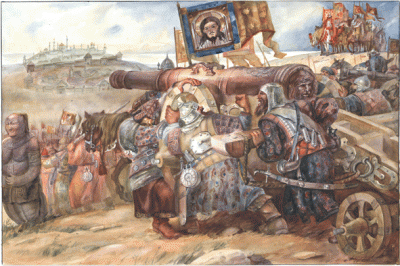 One of the oldest branches of the Russian army is artillery. So, the first appearance of gunshot artillery in Russia dates back to the XIV century, or more precisely, to the 1389 year. But this is only an officially recognized date, according to numerous studies by Russians, and later by Soviet historians, artillery appeared much earlier than this date.
One of the oldest branches of the Russian army is artillery. So, the first appearance of gunshot artillery in Russia dates back to the XIV century, or more precisely, to the 1389 year. But this is only an officially recognized date, according to numerous studies by Russians, and later by Soviet historians, artillery appeared much earlier than this date. All story Russian artillery is surrounded by rich martial traditions. For several centuries, Russian artillery remained the strongest in the world, and in large part because of this, victories in numerous wars were obtained.
Like the entire Russian army, artillery has passed a difficult path of development and formation. The first guns were not examples of perfect designs. Most of the guns were made in an artisanal way. For their manufacture used wrought iron and strengthened on mobile wooden machines. Iron pieces and processed stones were used as charges. Beginning in the second half of the 15th century, a new era began in the production of tools. For ebbing guns began to use bronze and copper, which accordingly affected the quality of shooting.
But the most extensive development of artillery began with the arrival of Ivan the Terrible on the Russian throne. In all the wars in which Russia took part at that time, artillery played a decisive role. Under the reign of Ivan the Terrible, artillery was formed as a separate branch of troops. Thus, according to historical data, separate archery regiments were created, which included artillery. At its core, it was the creation of regimental artillery.
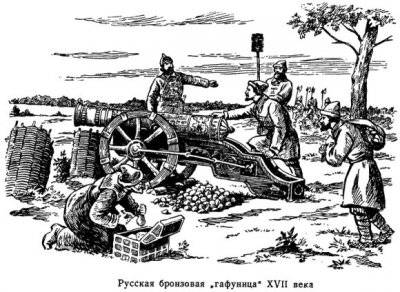 During the reign of Ivan the Terrible, Russian artillery was represented on the battlefields as a separate branch of troops, which is able to independently solve the most complex combat missions. The most significant fact of the use of artillery at that time was the siege of Kazan in 1552. For the capture of the fortress, 150 heavy weapons were used, of which shelling the fortress walls was fired for a month and only because of this the Russian army was able to occupy the city. Artillery also played a very important role in the Livonian War. During the military confrontation, the Russian army led intense battles for enemy fortresses. During their participation in these battles, the Russian gunners proved not only how well they own their equipment, but also its strength and firepower.
During the reign of Ivan the Terrible, Russian artillery was represented on the battlefields as a separate branch of troops, which is able to independently solve the most complex combat missions. The most significant fact of the use of artillery at that time was the siege of Kazan in 1552. For the capture of the fortress, 150 heavy weapons were used, of which shelling the fortress walls was fired for a month and only because of this the Russian army was able to occupy the city. Artillery also played a very important role in the Livonian War. During the military confrontation, the Russian army led intense battles for enemy fortresses. During their participation in these battles, the Russian gunners proved not only how well they own their equipment, but also its strength and firepower. At the end of the XVI and in the beginning of the XVII centuries, completely new artillery guns appeared in Russia, which proved the successful solution of extremely difficult tasks for the time by the Russian casters. The tools were created by talented craftsmen, most of whom came from the common people.
So, there are a number of vivid historical examples that prove that already in the early period of the existence of artillery in Russia there were gifted craftsmen who cast and forged guns. One of the first cannon masters, whose name history has brought to our time, was Jacob, he lived and worked fruitfully in the second half of the 15th century. The period of time also includes the activity of the cannon master from Tver, Mikula Krechetnikov, who quite successfully competed in the manufacture of artillery guns with foreign masters and was largely ahead of them. The hands of Krechetnikov created a lot of guns, which were included in the arsenal of artillery weapons of the Russian army.
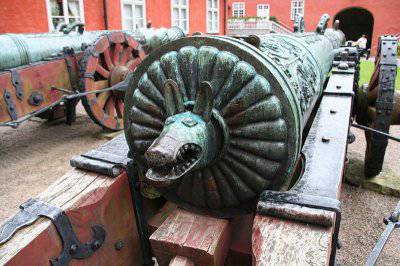 But the most famous Russian master of the gun business was Andrei Chokhov. This talented master cast a lot of different tools, but the Tsar Cannon cast by him brought the greatest celebrity to this man. Despite the fact that the manufactured gun in the 1586 year never fired, it still attracts the attention of the Moscow Kremlin visitors and experts. For the most part, attention is drawn to the size of the gun. It has a caliber of 89 centimeters, its length is 5 meters, and its weight is about 40 tons. No foreign cannon master managed to cast anything like that, and this once again emphasized the talent and art of Russian masters.
But the most famous Russian master of the gun business was Andrei Chokhov. This talented master cast a lot of different tools, but the Tsar Cannon cast by him brought the greatest celebrity to this man. Despite the fact that the manufactured gun in the 1586 year never fired, it still attracts the attention of the Moscow Kremlin visitors and experts. For the most part, attention is drawn to the size of the gun. It has a caliber of 89 centimeters, its length is 5 meters, and its weight is about 40 tons. No foreign cannon master managed to cast anything like that, and this once again emphasized the talent and art of Russian masters. Even at an early period in the history of artillery in Russia, guns were created that, according to the idea of the device used and the principles underlying their actions, were much ahead of the corresponding counterparts of guns created abroad. For the most part, this refers to the creation of rifled tools and tools with wedge bolts. It is known that with the introduction of rifled guns into artillery of the Russian army, in the middle of the XIX century there was a real revolution in artillery technology. First of all, this was due to the fact that rifled artillery had a much greater power of fire compared to smooth wall. The guns of the new model were distinguished by a greater range, as well as increased accuracy when firing. Considering all these advantages, it is not surprising that the rifled guns almost immediately took the leading place on the fields of combat battles and had a significant impact on the development of artillery firing and its tactics.
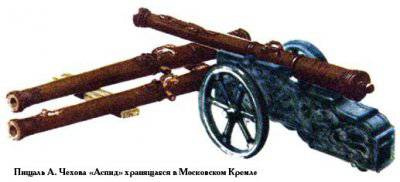 At the end of the XVI century, Russian masters first made an iron pishchal, which had an 1,7 caliber of inch and was charged from the breech. There were grooves in the channel, and on its trunk there were provisions for mounting the sight and the front sight. Shooting from this food was made by special oblong projectiles. Russian craftsmen continued to improve their food, and thanks to this a completely new model, cast in bronze in 1615, appeared. In the barrel channel, ten spiral threads were made, like the previous model, it was charged from the breech and closed with a wedge gate.
At the end of the XVI century, Russian masters first made an iron pishchal, which had an 1,7 caliber of inch and was charged from the breech. There were grooves in the channel, and on its trunk there were provisions for mounting the sight and the front sight. Shooting from this food was made by special oblong projectiles. Russian craftsmen continued to improve their food, and thanks to this a completely new model, cast in bronze in 1615, appeared. In the barrel channel, ten spiral threads were made, like the previous model, it was charged from the breech and closed with a wedge gate. The indicated foodstuffs are the very first rifled guns in the world, which were made by Russian craftsmen. Abroad, there are several specimens of guns with rifled barrels, which were made only at the end of the XVII century. It is obvious that Russian gunsmiths in the invention of rifled guns were much ahead of foreigners. The only disadvantage that did not allow for the mass production of rifled guns at that time was the absence of the necessary conditions for production.
With the development and improvement of the production of guns, there was a problem with the transition to a new type of weapon loading. As you know, the first guns were charged directly from the barrel, but a more reliable and fast method of charging was required. This method was the loading of weapons from the breech. This required only one thing - a reliable device for locking the bore of the gun. This task was successfully solved by the Russian gunsmiths, using a wedge bolt for locking the barrel, which at that time was not used in the artillery of other countries' armies.
The beginning of the XVII century is the birth of the Russian artillery science. The first scientific work, which is known to historians of our time, belongs to Onisim Mikhailov - “Pushkar master affairs”, which he wrote in 1620, and is called “The Charter of cannon military and other matters related to military science”. For more than 150 years the manuscript remained unknown, and only in 1777 was it found and published by V. Ruban.
Onisim Mikhailov’s scientific work consisted of 663 decrees, as well as containing many truly revolutionary original thoughts. Mikhailov was not only able to summarize many of the provisions known in foreign literature, but also provided an independent solution to a number of issues that concerned organization, combat use and the material part of artillery. With his work, Mikhailov laid the foundation for the further development of artillery literature in Russia and, not least, made a valuable contribution to the development of artillery science.
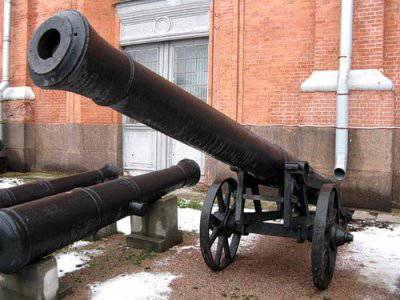 The beginning of the XVIII century became the most important stage in the formation of Russian artillery. It was during this period that Russian artillery became the best in Europe. For the most part, this was achieved thanks to the perseverance, energy and organizational skills of Peter the Great and his combat comrades in artillery - G. G. Skornyakov-Pisarev, Ya. V. Bruce, V. D. Korchmina and many others who believed in the future of artillery . Creating a regular army in a new fashion, Peter the Great, in fact, rebuilt the structure of artillery on new principles. A number of government measures that Peter I carried out were of great importance for the further development and growth of artillery.
The beginning of the XVIII century became the most important stage in the formation of Russian artillery. It was during this period that Russian artillery became the best in Europe. For the most part, this was achieved thanks to the perseverance, energy and organizational skills of Peter the Great and his combat comrades in artillery - G. G. Skornyakov-Pisarev, Ya. V. Bruce, V. D. Korchmina and many others who believed in the future of artillery . Creating a regular army in a new fashion, Peter the Great, in fact, rebuilt the structure of artillery on new principles. A number of government measures that Peter I carried out were of great importance for the further development and growth of artillery. So, Peter the Great streamlined the issue related to the production of artillery shells. The abundance in artillery was abolished. For the production of guns used only standard drawings. The creators of the guns were tasked with reducing the weight and achieving maximum maneuverability of the gun on the battlefield. As a result, completely new samples of howitzers and cannons appeared in the army, which had high combat qualities and high maneuverability and much simplified and facilitated transportation.
Peter I attached great importance to the maneuverability and mobility of artillery on the battlefield. He did his best to ensure that on the battlefield not only infantry, but cavalry always had the support of artillery. To this end, such units as horse artillery were introduced in the Russian army. Created by Peter I, the horse artillery took part in the battle with the Swedes in 1702 and the battle of Lesnaya in 1708, along with cavalry regiments, and historians recognize that it was thanks to this that victories were won. The horse artillery of the Russian army during the Patriotic War 1812 of the year and the foreign campaigns of 1813 – 1814 that followed it became especially famous.
Special importance in the further development of artillery was given to personnel training. Peter the Great not only personally mastered the artillery business, but also invested a great deal of work in identifying talented people and teaching them the art of artillery combat. It was during this period that the foundation was laid for the development of artillery education in Russia. The efforts spent on the reorganization of the Russian army and its artillery, very quickly paid off and, with a hundredfold. Particularly great success fell on the Russian artillery during the battle of Poltava 1709 year. As you know, the Swedish invaders were finally crushed. Russian artillery fired a massive fire, shooting at point-blank shot by Swedish troops rushing into the attack, which led to heavy losses in the camp of the enemy. The effectiveness of the Russian gunners recognized even enemies.
Further progress in the development of Russian artillery was associated with the name of PI. Shuvalov. This outstanding gunner in the middle of the XVIII century stood at the origins of improving the organization of artillery. Thanks to Shuvalov, more advanced weapons were adopted, and the level of combat and technical training of artillerymen significantly increased. Pyotr Shuvalov was able to attract talented inventors, including Major Danilov and Colonel Martynov, to create new tools. Thanks to this talented tandem, a completely new weapon was created - a unicorn, which served the Russian army for more than a hundred years. As a basis for the unicorn project, a long howitzer, built under Peter the Great, was used. But in the new gun, the barrel was extended to 8 caliber. New guns were intended for firing various types of shells: incendiary shells, explosive grenades, canister, cores. They had special conical chambers, which made it possible to speed up the charging process.
The heroic and skillful actions of the Russian artillery, manifested in the second half of the XVIII century, were inextricably linked with the outstanding successes of the Russian weaponsachieved under the command of talented Russian generals M. I. Kutuzov, P. A. Rumyantsev and A. V. Suvorov.
PA Rumyantsev made a number of important provisions and changes on the combat use and organization of artillery. Applying these provisions, the Russian gunners achieved significant success in the battles with the Turkish army. In particular, it should be noted how the Russian artillery acted in the battles of Larga and Cahul. In these battles, the Russian artillery was able to suppress the fire of the Turkish artillery and dealt a significant blow to the enemy cavalry, and this ensured the complete and final defeat of the Turkish troops.
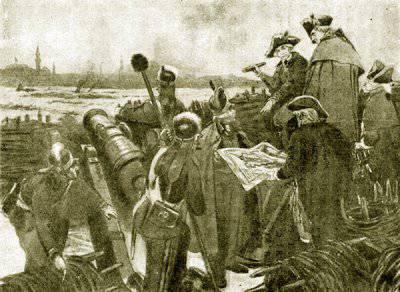 Even more impressive were the successes of the artillery of the Russian army in the battles under the command of the famous A. Suvorov. The commander knew artillery perfectly and correctly estimated its combat capabilities. When setting the task for the artillerymen, Suvorov was always brief: "The Crossfire opens the victory for the infantry." The commander always demanded that the artillery units prepare the attack of the infantry and cavalry. Russian artillery together with the Suvorov troops participated in the march to distant Italy, and due to its power a whole series of defeats were inflicted on the French army.
Even more impressive were the successes of the artillery of the Russian army in the battles under the command of the famous A. Suvorov. The commander knew artillery perfectly and correctly estimated its combat capabilities. When setting the task for the artillerymen, Suvorov was always brief: "The Crossfire opens the victory for the infantry." The commander always demanded that the artillery units prepare the attack of the infantry and cavalry. Russian artillery together with the Suvorov troops participated in the march to distant Italy, and due to its power a whole series of defeats were inflicted on the French army.The beginning of the XIX century was marked by bloody wars between Napoleonic France and the coalition of states, which included Russia. The Russian army and its artillery met with the front line at that time and well-armed, trained, led by talented generals and marshals of the French army. In heavy battles with the Napoleonic army, victories and defeats alternated. The worst defeat for the Russian army was the lost battle of Austerlitz in 1805.
 In 1812, the French army, led by Napoleon, invaded Russia. So the war began, which is justly called Patriotic. The Russian people were forced to defend their state from the French invaders. But for Napoleon, this war ended in complete defeat and expulsion from Russia. The most significant and decisive in the course of this war was the battle of Borodino. The French lost this battle, and thereby buried their former glory, won over the years. And as the French themselves admitted, at the base of their defeat lies the excellent artillery preparation of the Russian army, which was able to inflict considerable damage in their camp.
In 1812, the French army, led by Napoleon, invaded Russia. So the war began, which is justly called Patriotic. The Russian people were forced to defend their state from the French invaders. But for Napoleon, this war ended in complete defeat and expulsion from Russia. The most significant and decisive in the course of this war was the battle of Borodino. The French lost this battle, and thereby buried their former glory, won over the years. And as the French themselves admitted, at the base of their defeat lies the excellent artillery preparation of the Russian army, which was able to inflict considerable damage in their camp.Artillery continued to operate successfully in the period of the famous counter-offensive of the Russian army, which was led by M. I. Kutuzov, and which finally destroyed Napoleon’s army. The French army experienced the power of the Russian artillery strikes in the battles of Dorogobuzh and Vyazma, under Maloyaroslavets and Krasny.
In subsequent wars after this, the military glory of the artillery of the Russian army grew and strengthened. A lot of glorious and heroic pages in the history of Russia were entered by gunners during the defense of Sevastopol in the 1854-1855. from the Anglo-French-Turkish invaders. In the battles for the city, Russian artillerymen proved not only their skills, but also their ingenuity, resourcefulness and heroism. At the bastions of the city and on Malakhov Kurgan, the invaders lost tens of thousands of soldiers and officers from artillery fire.
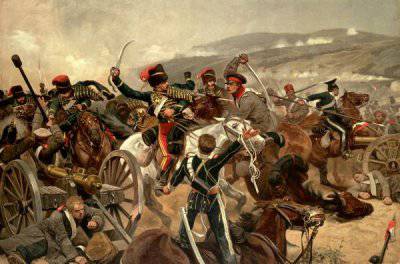 As is known, the Crimean War 1853 – 1856. was the last in which smooth-bore guns were used. These guns no longer met the requirements for artillery requirements. A period of large-scale re-equipment of all the armies of the world with rifled guns began, after a short time, high-speed guns also appeared. Russian inventors, designers and scientists have made a significant contribution to the solution of issues related to the creation of an improved artillery materiel, as well as the development of the basics of its combat use.
As is known, the Crimean War 1853 – 1856. was the last in which smooth-bore guns were used. These guns no longer met the requirements for artillery requirements. A period of large-scale re-equipment of all the armies of the world with rifled guns began, after a short time, high-speed guns also appeared. Russian inventors, designers and scientists have made a significant contribution to the solution of issues related to the creation of an improved artillery materiel, as well as the development of the basics of its combat use. During the 19th century, quite a lot of major successes were achieved in the development and improvement of artillery science and technology. Russian mathematicians N. I. Lobachevsky, P. L. Chebyshev, and M. V. Ostrogradsky made their revolutionary changes and innovations in artillery science. On the basis of their mathematical solutions, many issues related to internal and external ballistics, as well as artillery firing, were developed and solved.
Russian scientists - artillerymen N.A. Zabudsky and N.V. Mayyevsky were awarded fame and international recognition. Their studies on the use of rifled guns, the flight of oblong shells and on the issues of internal and external ballistics are classic works that most fully and in an original way represent the solution of the tasks of artillery technology and science. The works of N. A. Zabudsky and N. V. Maievsky were translated into foreign languages and were praised by scientists from other countries.
It is necessary to recognize that in Russia considerable attention was paid to the development of artillery affairs, and scientists who invested their contribution to the development of artillery were quite a lot. Thus, Professor A. V. Gadolin was able to solve the problem associated with an increase in the resistance of the gun barrel to the pressure of powder gases. The theory developed by A. V. Gadolin on the use of multi-layered barrels over a long period of time was used in the design of artillery systems.
Information